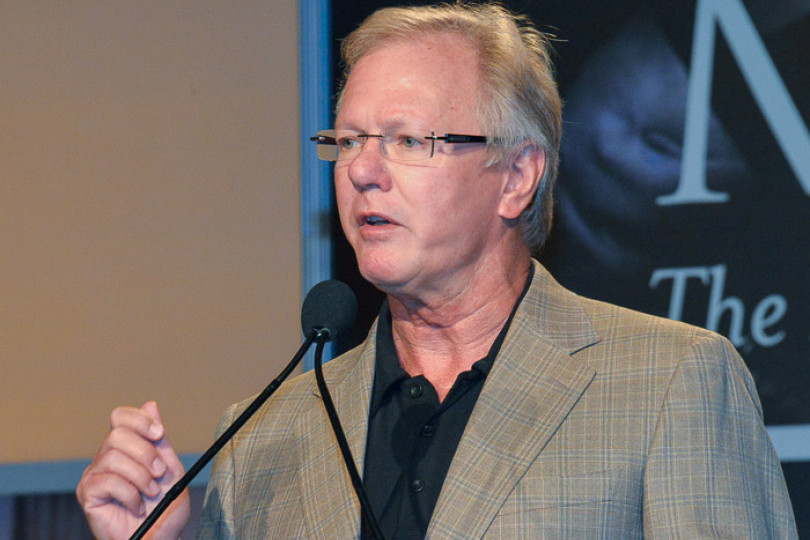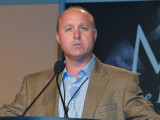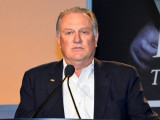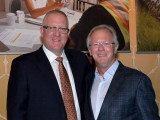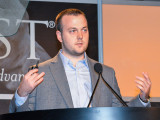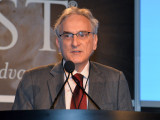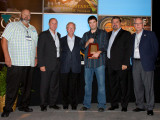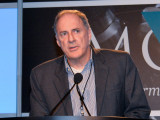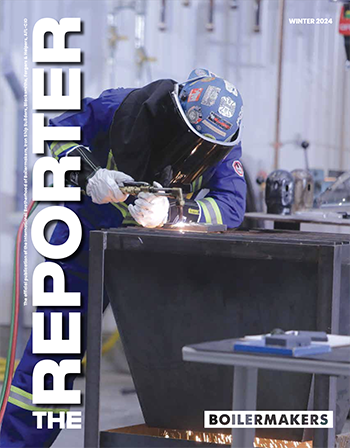IP Newton B. Jones introduces The Boilermaker Code program.
View Photo Gallery (8 photos)
IP Jones calls trust “an engine of progress and innovation”
THE NATIONAL TRIPARTITE Alliance conference held in Myrtle Beach, S.C., October 6-8 held special significance for participants as they celebrated the 25th anniversary of the Mobilization, Optimization, Safety and Training (MOST) trust. About 350 people attended, including owner and contractor representatives, and construction lodge business managers.
In his opening remarks, International President Newton B. Jones spoke about MOST’s inception in 1989 as a pioneering effort to solve construction industry challenges, calling it “an engine of progress and innovation.” He cited two new programs that will add value to the Alliance: the MOST Boilermaker Delivery System (MBDS) and the Boilermaker Code.
The MBDS, coupled with referral rule changes, allows members to update their profiles and sign onto work lists online while offering the union and contractors accurate data about member skills and availability.
IP Jones said the new Boilermaker Code and Creed will serve as a guide for optimum jobsite performance, adding value, enhancing the Boilermakers’ reputation and securing work for current and future Boilermaker generations. He showed a film titled “The Boilermaker Code: Ending the Red Ass Era,” which depicts negative behavior and introduces the Boilermaker Code program.
Later in the conference, Director of Construction Division Services Dale “Skipper” Branscum outlined the new Boilermaker Code training program now under development.
Speakers tackle industry topics
TRIPARTITE AND GUEST speakers discussed a range of opportunities and challenges impacting alliance partners.
SEAN MCGARVEY, President of North America’s Building Trades Unions, spoke about the need for all trades to pursue excellence on the job and secure positive relationships with owners and contractors. “For several years, our unions have collectively been hard at work to rebuild the brand for North America’s Building Trades Unions,” he said.
In viewing the Boilermaker Code film, McGarvey stated, “I was struck by its honesty and the willingness of this great union to hold a mirror up to itself and ask the fundamental question of ‘How do we get better?’”
McGarvey added, “We embrace the notion that re-constituting a successful brand for the 21st Century requires us to see what we do through the eyes of the owner and contractor partners. I want to thank the membership of the Boilermakers for embracing our new value structure and our code of excellence.”
NACBE President GREG PURDON contrasted 1989, the year in which MOST was founded, and the current year of 2014 in terms of fuel sources for power generation and safety performance. He pointed out that total energy output in those two comparison years has changed very little and that despite all the hype renewables represent only about 6.5 percent of total U.S. power generation today.
Purdon stressed that safety performance in the comparison years has seen impressive changes, thanks to MOST. “Monumental improvements have been achieved in the OSHA recordable rate and the lost time injury rate. This is something we all should be proud of.”
STEPHEN FOTIS, Partner with VanNess Feldman, and MARK MOREY, Director of Fuel Intelligence for Alstom Power, gave individual presentations on energy topics.
Fotis summarized the raft of EPA regulations developed in recent years that impact new and existing-source coal-fired power plants. He noted that the regulations seek not only to restrict greenhouse gas emissions but also affect waste ash, effluents and water use. He said these rules place incredible stress on the energy industry, but legal challenges continue to make the future of some of these rules uncertain. Morey explained ongoing changes in Europe’s power and energy markets. He said Europe’s power generation is well diversified and that Europe has established clear objectives for 2020, including 20 percent reductions in CO2 emissions, a goal of 20 percent renewables and a 20 percent increase in energy efficiency.
MAXX CHATSKO, editor of SynBioBeta, asked conference participants, “What if, instead of treating CO2 as a waste product, we could use it as a feedstock in biochemical manufacturing to produce valuable products?”
Chatsko cited a number of high-tech companies that are researching processes — and in some cases already using them — where CO2 forms the building block for products such as automobile tires, sucrose and ethylene glycol (a compound used in the manufacture polyester fibers and products).
Chatsko said that in addition to creating valuable products, the biochemical use of CO2 could cut emissions by more than 90 percent, reduce petroleum demand, lower prices for consumers, boost profits and create jobs. He said a number of large companies are investing in these technologies, such as BP, Siemens and Google. He invited tripartite participants to look at ways to collaborate in the effort to use CO2 as a productive commodity rather than a waste product.
STEVE MOORMAN, Babcock & Wilcox’s Manager of Business Development for Advanced Technology, addressed the status of carbon capture and storage technologies in light of the EPA’s CO2 regulations. He cited projects such as the all-new Kemper IGCC power plant in Mississippi and FutureGen in Illinois, which upgrades an existing plant, as examples of large-scale CCS efforts partially funded by the Department of Energy.
“In my opinion, the average utility would find it hard to make a business case for developing one of these [CCS] plants.”
— Steve Moorman
Moorman said these projects are developing slowly and that pre-combustion and post-combustion technologies are both expensive and complex. He said the few plants being built with CCS technology cost up to three times as much as super- and ultra-supercritical facilities, making them cost prohibitive to build.
“In my opinion, the average utility would find it hard to make a business case for developing one of these plants,” he said.
Moorman added that some plants can help offset the high cost of CCS because they are located near oil fields that can use CO2 for enhanced oil recovery, but siting limitations often make this option unavailable for many facilities.
Local 11 Receives Charles W. Jones Award
THE CHARLES W. JONES Award, which honors the local lodge demonstrating the highest use of seven specified MOST programs during the preceding year, went to Local Lodge 11 of East Helena, Mont. International President Newton B. Jones presented the award to L-11 BM-ST Jess LaBuff, who accepted it on behalf of the lodge members.
MOST Administrator Roger Erickson pointed out that since the award was established, participation rates in the various programs have improved markedly.
Caucus breakouts fuel debate
CAUCUS BREAKOUTS, A staple of tripartite meetings, generated discussion on various industry issues as owners, contractors and business managers met in separate groups to identify challenges and potential solutions. Leading the breakouts were owner co-chairs Jerry Payton, TVA, and Joe Hegendeffer, KCP&L; contractor chair Greg Purdon, Enerfab; and union chair Kyle Evenson, Boilermakers. The caucus chairs later presented summaries of their meetings to the full conference for consideration and discussion.
IN ADDITION TO celebrating the 25th anniversary of MOST, the National Tripartite Alliance conference also presented an opportunity to recognize several individuals whose service has left an indelible mark on the partnership and the union.
During the conference, International President Newton B. Jones called Brad Bradford to the podium for a surprise presentation of the Charles W. Jones Award, the highest honor presented by the Brotherhood for personal achievement. Bradford is chairman of the MOST Marketing Committee and has long been involved in leadership roles within the National Tripartite Alliance.
IP Jones also presented a commemorative plaque for distinguished service to Ed Vance during the annual Southeast Area Tripartite Alliance/Southeast Business Managers dinner held off-site. Vance, a 35-year member of Local 455 (Muscle Shoals, Ala.), retired in 2014 as Business Manager/Executive Secretary of District 57 in Chattanooga, Tenn. The District provides administrative support for Local 455, Local 263 (Memphis, Tenn.), Local 454 (Chattanooga), and Local 466 (Rock Hill, S. C.).
